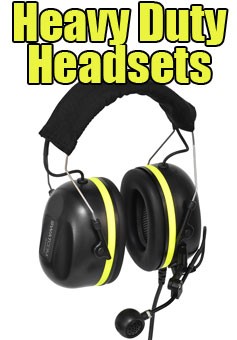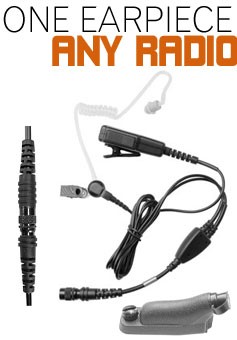
An earbud is a type of in-ear headphone, typically small and portable, designed to fit directly outside the ear canal. Unlike traditional headphones that cover the ear or earpieces that are inserted into the ear canal, earbuds rest just at the entrance. This design allows for a degree of ambient sound to enter, enabling users to remain aware of their surroundings.
They're widely used for listening to music, making phone calls, and as accessories for portable media devices, smartphones, and computers. Their compact size and lightweight nature make earbuds a popular choice for people on the go.
An earpiece, in contrast to an earbud, is designed to fit snugly inside the ear canal. This design offers a more direct delivery of sound and typically provides a higher level of sound isolation from external noises. Earpieces are often used in environments where clear communication is critical, such as in security details, customer service, and broadcast situations.
They can also be found in personal audio devices where the listener desires a more immersive audio experience. Due to their in-ear design, earpieces can deliver enhanced bass and overall sound quality compared to earbuds, making them a preferred choice for audiophiles and those seeking a more intimate listening experience.
Connections
The connectivity options for earbuds and earpieces vary, adapting to the needs of their primary user base. Earbuds often come in both wired and wireless varieties. Wired earbuds typically use a 3.5mm jack or a USB connection to connect to a wide range of devices including smartphones, laptops, and tablets. Wireless earbuds usually employ Bluetooth technology to connect to devices, offering users freedom from cables and greater mobility.
Earpieces, as well, feature both wired and wireless options, but their design may prioritize connectivity features that cater to professional use. For instance, radio earpieces connect to two way radios
The choice between earbuds and earpieces extends into their connectivity options, with earbuds frequently being favored for everyday listening and casual use, while earpieces are often selected for specific applications where secure and clear communication is paramount.
Comfort and Wearability
One of the primary considerations when comparing earbuds to earpieces is the aspect of comfort and long-term wearability. Earbuds, designed for general use, offer a fit that accommodates a wide range of ear sizes and shapes.
Many models include interchangeable tips to further enhance fit and comfort. However, for some users, earbuds can become uncomfortable over extended periods, potentially causing ear fatigue.
Earpieces, on the other hand, are often crafted with ergonomics in mind, aimed at professionals who may need to wear them for many hours at a stretch. Their design may include features such as over-the-ear hooks or custom-molded ear tips, which not only provide a more secure fit but also enhance comfort during prolonged use. This focus on wearability makes earpieces a more appealing option for those requiring long-term use without compromising on comfort.
Sound Quality
When discussing sound quality, it's crucial to consider the structural differences between earpieces and earbuds, particularly the fact that earpieces typically occupy only one ear, while earbuds are designed for both.
This fundamental distinction significantly impacts the auditory experience. Earpieces, used primarily in one ear, are optimized for clear, precise communication rather than immersive audio experiences. They focus on delivering vocal clarity, making them ideal for calls or professional communication, where understanding speech is paramount.
On the other hand, earbuds, occupying both ears, offer a more immersive listening experience. They are designed to provide a balanced soundstage, where both the subtleties of high notes and the depth of bass can be appreciated in harmony.
This stereo effect, achieved by engaging both ears, enhances the overall richness and dimensionality of music or any audio content. However, the quality of this immersive experience largely depends on the earbuds' build and sound drivers.
High-quality earbuds can deliver exceptional sound fidelity, rivaling that of over-ear headphones, while lower-quality models might provide a less satisfying auditory experience.
Design and Fit
The disparity in design and fit between radio earpieces and earbuds becomes especially pronounced when considering their price points. Generally, more affordable options in both categories tend to compromise on the quality of materials used, directly impacting the fit and comfort level.
Cheaper radio earpieces, for instance, often lack the adjustable features and ergonomic design found in higher-end models. This can result in a less secure and uncomfortable fit, particularly during extended use, which might not suit all ear types.
Similarly, budget earbuds tend to offer a one-size-fits-all solution, disregarding the diversity in ear shapes and sizes among users. This can lead to a less snug fit, causing the earbuds to fall out easily, especially during physical activities. Additionally, the cheaper materials used in budget earbuds may not provide the same level of comfort as their premium counterparts, potentially leading to ear fatigue or discomfort over time.
Audio Delay
Audio delay, often encountered with wireless technology, is the brief lag between when a sound is initiated and when it's actually perceived. This issue is particularly noticeable with Bluetooth earbuds compared to earpieces. When engaging in activities like watching movies or playing video games, opting for wired earpieces might be beneficial as they typically do not have this problem.
Audible Spillage
Audible spillage, the phenomenon where sound escapes from the user's audio device, allowing others to hear it, varies significantly between earbuds and earpieces. Earpieces, with their closer fit in the ear canal, usually result in less sound leakage. This makes earpieces a superior choice for environments requiring quiet, such as libraries or silent workspaces.
Resistance to Moisture and Perspiration
Considering the level of moisture and sweat resistance is imperative for users leading an active lifestyle or those frequently using their devices in the great outdoors. Earbuds and earpieces are increasingly offering water resistance features.
In summary, when selecting between earbuds and earpieces, one must consider various factors including comfort, audio delay, audible spillage, and resistance to moisture and perspiration. While budget earbuds may be more affordable, they often fall short in providing long-term comfort and may lead to ear fatigue.
Audio delay is another critical aspect, with wired earpieces offering an edge for activities like gaming or watching films due to their minimal latency. Furthermore, earpieces tend to offer better control over audible spillage, making them ideal for quiet environments.
Lastly, for those leading an active lifestyle or using their devices outdoors, opting for models with significant moisture and perspiration resistance, such as the Uprise wireless earbuds, is crucial for durability and reliability.
-

Flare CALMER earplugs
Calmer® is a revolutionary product designed to diminish irritating noises ...
-

Flare EarShade Earplug
Earshade® offers a unique, comfortable, and customizable experience with i...



























